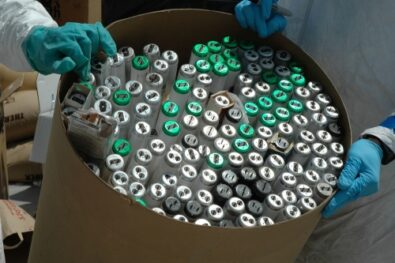Are You Handling Your Universal Waste Correctly?
December 23, 2014
Handling Universal Waste: A Quick Guide
The Environmental Protection Agency’s (EPA) ruling on universal wastes on May 11, 1995 was a boon for industrial waste recyclers. The ruling was finalized in order to encourage and further expedite the recycling and treatment of specific commercial and industrial wastes.
From that point on, some wastes formerly considered hazardous wastes were now to be regarded as non-hazardous if the generators met treatment, recycling, or collection standards set out by the EPA. Hazardous waste generators, to their benefit, now can choose whether they want to label these wastes hazardous or universal on a case-by-case basis.
Universal waste can include:
- batteries (other than lead-acid batteries),
- pesticides,
- mercury-containing equipment (such as mercury thermostats and thermometers),
- mercury-containing lamps (e.g. fluorescent, sodium vapor, mercury vapor, and metal halide), and
- paint or paint-related material.

If a generator chooses to designate these wastes as universal, the substances then become exempt from the restrictions of hazardous materials (HAZMAT) regulation.
One caveat is that some states may choose to not recognize this ruling as exactly spelled out by the EPA; they might have a longer or shorter list of allowed universal wastes, or tougher regulation on these wastes in general. Although most states do follow the federal ruling, it would be wise to first consult with your EPA state agency first before deciding to mark your wastes universal.
And though these wastes are excluded from the hazardous definition, they must be still be properly treated. Correct labeling, treatment, and storage are essential, as is knowing what type of handler you are.
Types of Universal Waste Handlers
Just as you have small quantity generators (SQG) and large quantity generators (LQG) of hazardous waste, universal waste also has its own classifications, set out by the overall weight of waste that is handled. The two types of handlers are:
- The small quantity handler of universal waste (SQHUW) – accumulates less than 5,000 kilograms on-site at any one time.
- The large quantity handler of universal waste (LQHUW) – accumulates 5,000 kilograms or more on-site at any one time.
It is pertinent to note that once you have reached large quantity handler status, you will continue to stay a LQHUW for the remainder of the calendar year—even if you only accumulated more than 5,000 kilograms of universal waste one time in a month and disposed of the waste immediately.
LQHUWs must also apply for an EPA ID number.
Labeling
Any stock of universal waste, whether containerized or not, must be labeled according to type of waste. If not labeled, these wastes will be assumed by an EPA inspector to be hazardous. The following labels are sufficient to let anyone know who might be inspecting that you have chosen to handle the wastes as universal:
- Universal Waste – Battery(ies); or Waste Battery(ies); or Used Battery(ies).
- Universal Waste – Pesticides; or Waste Pesticides.
- Universal Waste – Mercury Thermostat(s); or Waste Mercury Thermostat(s), or Used Mercury Thermostat(s).
- Universal Waste – Lamp(s); or Waste lamp(s); or Used lamp(s).
A label should be placed on every container or on the waste itself, and never on a wall or on the ground near the waste.
Storage and Accumulation Time Limits
A handler of universal waste may store their waste for up to a year. But some exemptions do apply, such as in cases where accumulation has not reached an amount which recyclers will be willing to pick up, or when more time is needed for the treatment, recovery, or disposal of the waste.
The law allows an extended period of time beyond a year in these cases, but should questions ever arise, keeping documents on-site that show you need longer than the federal limit is always a good idea.
Since there are storage time limits, keeping track of your when your wastes become universal is a wise idea. There are many ways to keep records of universal waste accumulation times and dates including,
- writing the earliest date that a waste is deemed universal on its label;
- keeping a manifest or inventory of all universal wastes and their accumulation dates; or
- keeping wastes in separate accumulation zones and noting the earliest date of wastes held in each area.
While there is no one standard way to do this, any method of timekeeping is preferable to none.
Treatment
Universal waste handlers may not treat or dilute their own waste on-site. However, exceptions are made for batteries and mercury-containing thermostats. For instance, you may remove the ampules in the thermostat which house the mercury, and still treat the thermostats as universal. The exemption for batteries is much the same, as it provides that the electrolyte may be removed by a handler on-site.
However, fluorescent light bulbs can never be treated as universal waste. All lamps and bulbs must be treated as hazardous waste under the Resource Recovery and Conservation Act (RCRA). But if you do choose to treat the light bulbs as hazardous waste, and you have a bulb crusher on-site, it must operate in a way that minimizes the release of gases into the atmosphere, such as in a fully-sealed drum or barrel.
Disposal
Universal waste may be sent to another handler for disposal, or a company that treats, stores, or recycles waste. All Department of Transportation (DOT) regulations apply when transporting the waste off-site.
Photo credit: Dennis Reed Jr. via compfight

